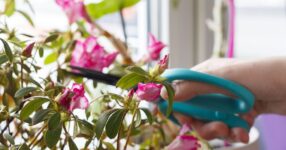
Plants to never prune in October or risk ‘sabotaging’ next spring’s glorious flower show
Pruning aims to remove dead, diseased and damaged stems and branches in order to improve the health of a plant.
However, it doesn’t just improve the health of a plant, it also maintains the look of it too.
Pruning at the correct time of year is crucial and can be the difference between a flowering garden and a non-flowering one.
Whilst all plants need to be trimmed at different times of the year, it’s a good idea to hold back pruning certain plants.
This includes plants such as rhododendrons, lilacs and certain varieties of roses.
Rhododendrons and azleas
Azaleas and rhododendrons should not be pruned at the end of summer or the start of autumn.
This is because it’s a time when the plant will be producing buds for new flowers the following year.
Brian Clayton, CEO and co-founder of GreenPal, said: “If you snip away in October, you’re essentially bidding goodbye to the upcoming spring’s vibrant bloom fest.”
Lilacs
If gardeners prune spring-flowering shrubs now, such as lilacs, they run the risk of removing flower buds for next year’s blooms.
The best time to prune beautiful lilacs is once they are done flowering in the late spring or early summer.
Brian noted that if the likes of dogwoods and lilacs are pruned now, gardeners are “sabotaging next spring’s flower show”.
Roses
While roses can be deadheaded in October, and climbing roses can be pruned, other varieties should be left alone.
Pruning often leads to a burst of fresh growth which can be immediately killed in the first frost at the end of October or November.
Pruning climbing roses in October is important, according to Monty Don, as it can help to improve the look of your garden.
In an October blog post, Monty wrote: “Rambling roses on the other hand produce their flowers on shoots grown on the previous summer so should only be pruned immediately after flowering.
“Start by removing any damaged or crossing growth or any very old wood which can be pruned right back to the ground.
“The main stems should be fanned out at an equidistance as horizontally as possible, tying them to wires or a trellis.
“Then all the side shoots growing from these main stems, which produced this year’s flowers, can be reduced to a short stub of a couple of leaves.”

![iOS 18.0.1 coming soon with iPhone and iPad bug fixes [Update]](https://trend.slink.ph/wp-content/uploads/sites/11/2024/10/iOS-18.0.1-336x220.jpg)

